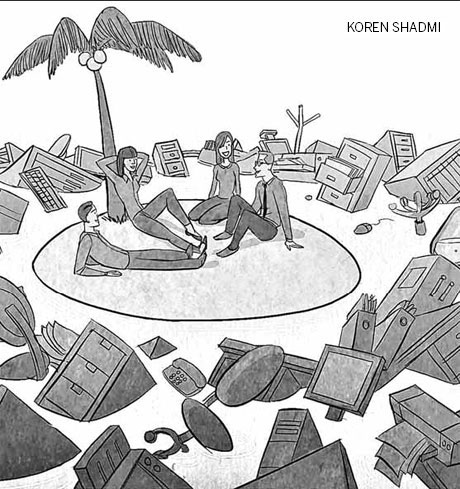Communal breaks offer a chance to bond
Updated: 2012-07-30 14:17
By Phyllis Korkki (The New York Times)
|
|||||||||||

What is one of the most important decisions a company can make? It's where to put the coffee.
Well-designed beverage areas are a surprisingly important contributor to productivity, according to Ben Waber, president and C.E.O. of Sociometric Solutions, a workplace consulting firm.
"In general when we look at what makes people happy and effective at work, it's being able to spend time with a close group of people," Dr. Waber said.
|
Related: |
But social breaks are also important to a worker's - and a company's - well-being. They reinforce bonds, improve morale and increase possibilities for collaboration.
Which brings us back to beverages. Sociometric recently worked with a pharmaceutical business that had many different pantry areas with no seating. And employees apologized to Dr. Waber about the awfulness of the coffee.
This represented "a big opportunity lost," he said. Sociometric recommended that the company remove many of the small spaces and create a big, central gathering area with ample seating - and better coffee.
As a result, people began mingling with a wider array of co-workers, and levels of collaboration and performance improved, Dr. Waber said.
Breaks are also meant for venting. Consider Sociometric's experience with call centers at a major bank. The bank had thought it would be more efficient to stagger workers' breaks.
Sociometric advised the bank to schedule breaks for a team together, with an alternate crew filling in. The results were a 25 percent improvement in the number of calls answered and a reduction in employee stress, Dr. Waber said.
No one was forced to socialize during the breaks, but the new schedule created a natural way for employees to vent about problems and seek help from one another, he said.
Technology companies have long embraced the concept of voluntary group breaks as a path to creativity and collaboration. In fact, the idea for Gmail was first conceived by a small group at one of Google's cafes, said Katelin Todhunter-Gerberg, a senior associate on Google's communications team.
Breaks are also good simply because they propel people out of their chairs. The evidence is overwhelming that prolonged sitting endangers workers' health.
Studies by Dr. Toni Yancey, a professor of health services at the University of California, Los Angeles, have shown that group exercise breaks can reduce sick leave and workers' compensation claims.
She developed a range of exercises for people who are "your typical overweight sedentary adults," wearing almost any attire. Ideally, the exercises are to be performed in two 10-minute sessions during the workday. People might dance to salsa music, say, or mimic the motions of pitching and batting in a baseball-themed program.
Dr. Yancey favors voluntary participation in a structured program supported by management. The force of the group, she says, is much stronger than individual good intentions.
The New York Times
Related Stories
Art beat: Festival 2012-07-27 13:18
Art beat: Concert 2012-07-27 13:17
Art beat: Art 2012-07-27 13:12
Art beat ... finger on the pulse 2012-07-27 07:31
Today's Top News
Rescuers race against time for quake victims
Telecom workers restore links
Coal mine blast kills 18 in Jilin
Intl scholarship puts China on the map
More bird flu patients discharged
Gold loses sheen, but still a safe bet
US 'turns blind eye to human rights'
Telecom workers restore links
Hot Topics
Lunar probe , China growth forecasts, Emission rules get tougher, China seen through 'colored lens', International board,
Editor's Picks

|

|

|

|

|

|





